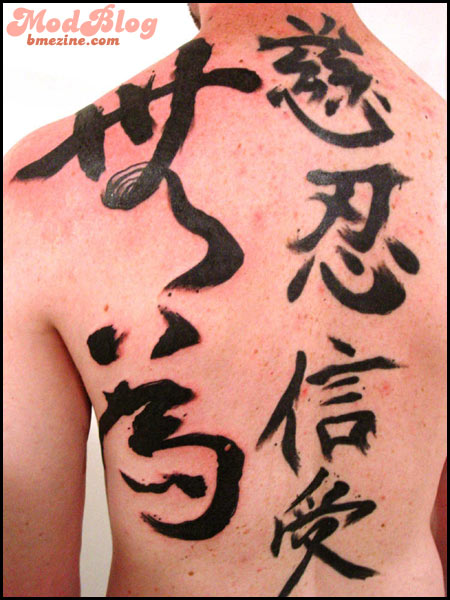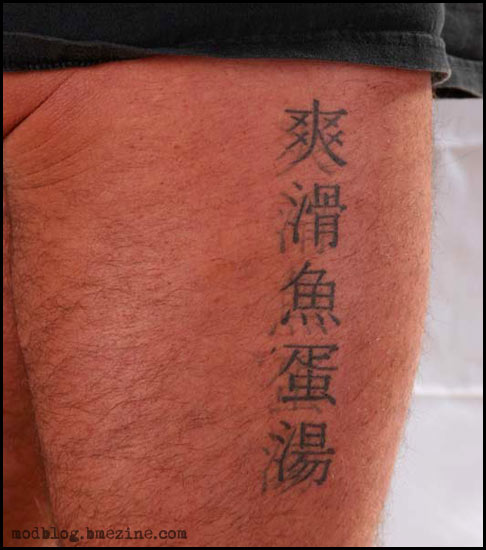I don’t know what this kanji tattoo means, but the the brushwork is gorgeous, but it’s by Karen Hall at Elemental Ink in Denver, CO.

This one on the other hand looks a little more familiar — 10 points to anyone who can translate it — and was done by Brian at Tattoo Extreme in Lynwood, WA. Before you make fun of Mark (who wears it), he says it was on purpose, and adds, “cheers to those that don’t check their kanji!”

 BME/News and Modblog highlight only a small fraction of what
BME/News and Modblog highlight only a small fraction of what
As near as I can tell, this is a menu item. The character by character translation is something like ‘bright, cunning, fish, egg, soup’.
Or, the Chinese language being what it is, it’s some obscure proverb dealing with crafty fish and soup.
Or neither. That’s what 5 years of language study will get you. I should have chosen Spanish.
i suppose this person likes fish egg soup(it came from the last three words)?hah.the first two words are an adjective which describes the soup as smooth and tasty.
Definalty strikingly different, nice work.
Hooray for Karen! She’s my artist, and she absolutely rocks my socks!
I remember seeing this before as well. Actually, my dad found the site that posts all these kanji tattoos and made me look at it. Haha.
ARE YOU SERIOUS?
That actually meant “Smooth and silky Fishball Soup”
I LOVE how the first one looks like actual paint strokes.
Everybody should check out hanzismatter.com – such a wealth of amazing/bad/funny Chinese tattoos.
the right four kanji in the guy’s script tattoo means “mercy, spy, truth/faith, receive/accept.”
but the left phrase is totally illegible. and i think the top left kanji might be backwards, but maybe not. it looks just like another kanji but mirrored, but even flipped around, makes NO sense. but, it’s an adjective or adverb describing a noun – a phrase, not a string of nouns – unlike the right portion.
For the first one, this is what he says it means:
“Wu Wei” (left) “Compassion, Patience, Acceptance” (spine)
And by the way, “Wu wei” is part of Taoism and refers to the idea of knowing when to act and when not to.
Wu wei? that doesn’t even make sense! it has a kanji, 1 or two hiragana, and another kanji! how can it be chinese, even?
adendum: the last kanji on the bottom left is “tame” (為) which is like sake/purpose/advantage. it can have other meanings i think.
I don’t know. This is what he said.
And I think that it’s the simplified version of “wu wei”
Am I the only one who doesn’t like this?
chinese and kanji have similar/or the same characters. that’s why some chinese people can recognize the japanese kanji but they have different meanings.
My jongwo and nihongo are way rusty… so I’m not sure what it reads… other than in ninogo, I see characters for stealth and to speak/talk (middle two on the right).
I think the strokes are amazingly realistic. I don’t like the placement, but I do like the look.
I don’t know anything about Kanji but I did do Chinese calligraphy for a short bit and the first one looks really amazing.
idea of ç¡çº: “there is no spoon”.
æ ï¹£kindness.
å¿?ï¹£restraint, non-retaliativeness.
ä¿¡ï¹£faith.
æï¹£love.
——-
the other one is totally cantonese. “ç½æ»éè湯” first two mean crispy and smooth, 3rd and 4th mean fishball, it is like matzoball, except you use fish paste, beat it into pulp and make it into a ball. the last one is soup. So it is some “nice fishball soup”-that maybe someone would like to have?
ooo I like how the first one looks so real.
http://www.hanzismatter.com/2006/10/this-is-tattoo-and-fish-ball-soup.html
I love how it looks 🙂
無 – if that is truly wu (as in wu wei) (in japanese – mu or nai “nothing”) it is the worst rendition of it i’ve ever seen, even if it is japanese calligraphy, which i’ve done. it still has like, mystery marks/hiragana below it, before 為. which doens’t mean spoon!!
if it’s 無為, it means “no benefit” or “no good”
ahhh, but i guess it’s all a bit different if it’s chinese, not japaense meanings. but still doesn’t explain why the “nothing/no” symbol is all fucked up.
Well, I’m so glad you guys like my brushwork. Unfortunately I tell all my clients that if they’re getting a tattoo in a language that I don’t speak, it’s up to them to do the research on the translation.
I’m always fascinated by tattoo work that replicates art that is done quickly. I mean, I’ve seen some great gestural tattoos; it’s stuff that if you did in charcoal, it would be five-ten minutes, tops, but probably took 3-4 hours or more to tattoo. Taking an art form that that is inherently slow and laborious and creating something that feels spontaneous, that’s talent.
I agree, it’s definietly beautifully done, even if no one can translate it
無為? it’s definitely not in chinese. i haven’t come across them being used together, EVER, not even in my trusty dictionary.
and 蛋 = egg!
so 爽滑魚蛋湯 means… “tasty, smooth fish egg soup”! well, where i come from, fishballs are known as yuyuan, or yuwan. and in cantonese, it’s actually yuyun. (sorry i can’t type chinese in my com) and i know cos i eat them for dinner almost 3 times a week!
he says he meant it as a gag. he could even go to a chinese restaurant, point to his leg/arm and say “can i have this?” sure, it’s funny, but i hope he doesn’t go to a place that’s predominantly chinese. he’s gonna get too many ‘omgwtf’ faces…
the top one is absolutely gorgeous. it really looks like it was painted on with a brush
I’m honestly having a hard time believing that the first one ISN’T paint. Gorgeous!
for the brush work…
yes they are all chinese….
the top one came from buddism…
it mean doing nothing or not capable of doing anything…
it’s a buddism idea….
and for the four characters…
the first one means kindness…
second one means endurance…
third one means trust or faith…
last one i think the artist made a mistake or whoever gave the brush work made a mistake…
they are probably trying to say love…
but they missed out some part so now it is endurance/bear/suffer…
or maybe they are meant to say suffer??
i’m not sure…
the second one is something you see in cantonese restaurant a lot..
it means crunchy, smooth fishball soup…
fish ball is made like meat ball…
the only difference is it will be grinded way finer…
and people consider fish ball to be good if it is smooth….
also it need to be crunchy…..(i don’t know how they do it but it just is…)…
whatever…
excuse my english./…
but at least i got chinese to make up for it:-D
btw….
i studied calligraphy before and i’m not sure if the brush work on the top one is done by the same artist…
the two on the left hand side is gorgeous…
but the four on the right hand side isn’t that great….
probably done by someone who knows the character but haven’t studied chinese brush calligraphy….
å¿?ï¹£tolerance
The brush strokes look nice.
i dont know any one who can read kaji so ive always wamted one that said egg roll or something
Emily, the two dots you’re seeing above the “third” character on the left are actually the first two strokes of what is in fact the second character. If they were closer to the body of the character, which they should be, it would be less confusing.
It’s unclear whether the person is using hanzi or kanji. The two large characters on the left seem to be in Japanese. 無為, read mu-i, is the Japanese rendering of wu-wei (the traditional and simplified Chinese can be seen at the Wikipedia article Wu wei, and both are quite different to the Japanese).
On the other hand, the characters on the right seem to be in Chinese. The last two are read shinju and mean belief or acceptance, but the first two are used as a name in Japanese, read Jinin, making it more likely that they’re Chinese.
Besides the generally muddled characters, while the brush effect is nice, the style of calligraphy really isn’t great. If it were real calligraphy, the ink would start out rich, thick black on the first characters and gradually become lighter and more streaky on the last ones. And finally, one should be able to draw a straight line that passes through the centre of each character in a given line of calligraphy, a test that this tattoo fails. All in all, I don’t like it.